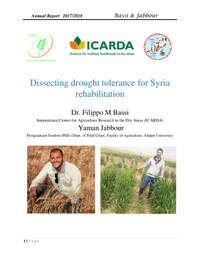Dissecting drought tolerance for Syria rehabilitation

Authors:
Wheat Triticum spp. is the most widely grown cereal crop in the world and one of the central
pillars of global food security (Rosegrant et al., 2001), about 728 million metric tons of wheat
was produced on 208 million hectares in 2013 (FAO, 2015).
By the year 2050, the world population is estimated to be 9 billion and the demand for wheat will
exceed 900 million tons. Fulfilling this demand is very challenging in the face of climate change,
increasing drought, heat stress, and emergence of new virulent diseases and pests. Offsetting these
challenges requires designing an effective wheat breeding strategy with the application of new
technologies and tools in order to develop varieties with high yield potential and
resistance/tolerance to abiotic and biotic stresses, and with acceptable end-use qualities. (Tadesse
et al., 2013).
Durum wheat (Triticum turgidum L. var. durum) is a self-pollinated tetraploid cereal crop (Soiano
et al.. 2018) grown in a range of climatic zones varying from warm and dry to cool and wet
environments (Giraldo et al., 2016) .The Mediterranean Basin is the largest durum producing area
worldwide (Bonjean et al., 2016). Drought is the main environmental stress that determines its
productivity (Mardeha et al., 2006), and often exacerbated by the incidence of extreme temperature
during the grain filling period causing high losses in production (Rajaram et al., 2006).
Drought is arguably the most important abiotic stress that affects wheat productivity in the world
and affects both source and sink strengths, leading to yield reduction up to 92% in wheat,
depending on the crop growth stage, duration and intensity of drought stress (Semenov et al.,
2014). The drought stress particularly during reproductive development reduces grain number and
grain size in wheat (Dolferus et al., 2011; Dong et al., 2017; Ma et al., 2017). Developing wheat
cultivar tolerant to drought stress occurring during reproductive phase is currently a big challenge
to wheat breeders (Cattivelli et al., 2008; Mwadzingeni et al., 2016).
Drought tolerance is not a qualitative trait, but a complex quantitative plant trait, that is controlled
by numerous genes and plant traits, with minor individual contributions (Blum, 2010; Dolferus et
al., 2013; Hu and Xiong, 2014; Serba and Yadav, 2016). Breeding for drought tolerant wheat
cultivar is made especially challenging due to the network of traits involved and their polygenic
control. This in turn results in high genotype by environment (G×E) interactions, low heritability,
and difficulty to conduct mass screening of plant traits and genes (Cattivelli et al., 2008; Fleury et
al., 2010; Hu and Xiong 2014). On the other hand, the narrow genetic base of many durum wheat
varieties ((Makai et al., 2016) selected under strong breeding pressure for identical target
objectives, does not seem to provide the amount of plasticity necessary to target such a complex
trait (Jing et al., 2013).
Compared with domesticated varieties, crop wild relatives and primitive wheat have been
challenged in natural environments for thousands of years and maintain a much higher level of
diversity (Zhang et al., 2016). Hence, interspecific hybridization between durum elite lines and wild relatives of the Gramineae family is a promising method to restore variability to the modern
breeding germplasm (Rajaram and Hettel, 1994).
For instance, Sall et al (2018) tested 24 durum wheat genotypes for tolerance to extreme heat along
the Senegal River, to reveal that the top and stable yielders were derived from interspecific
hybridizations with Triticum dicoccum and Aegilops speltoides. Similarly, Zaim et al (2017) was
able to confirm that crop-wild relatives crosses (CWR) out-yielded the best elites and cultivars
when tested across drought-prone environments in North Africa, and even showed better quality
characteristics.
